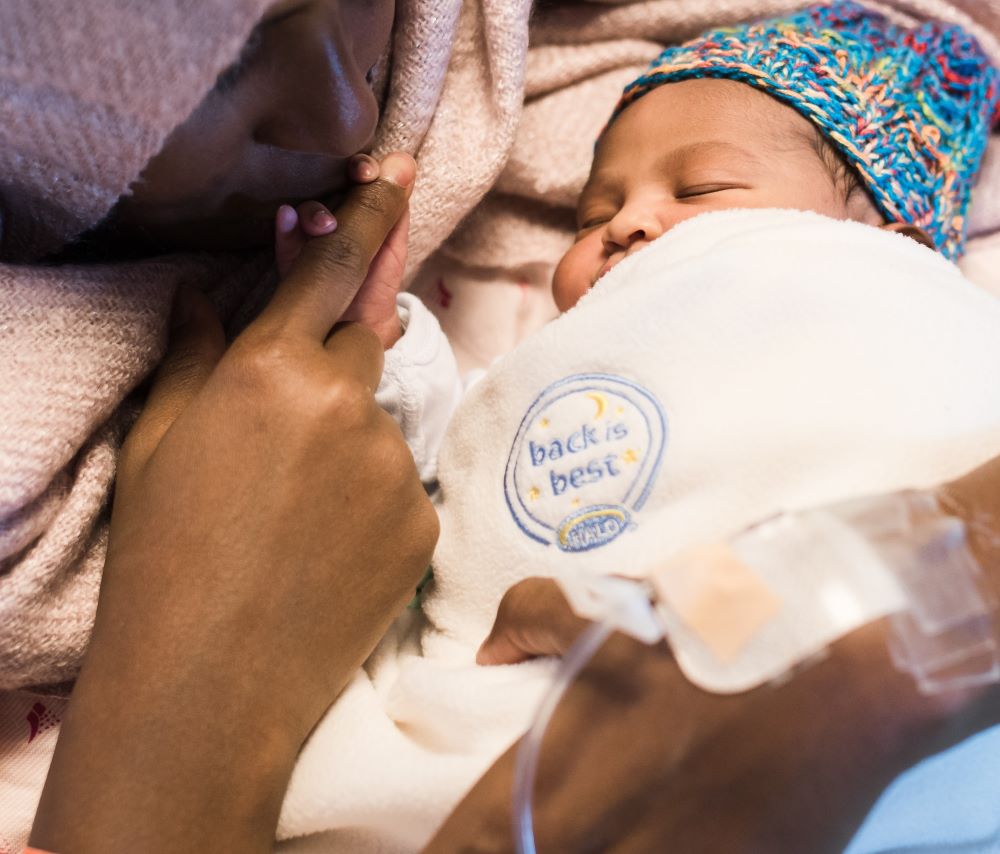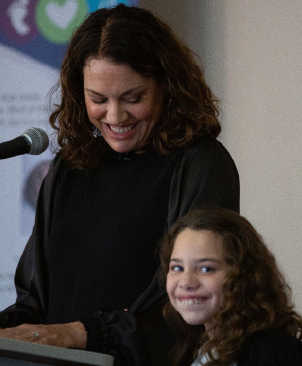2023 Public Health Laboratory Annual Report
Minnesota is the First in the Nation to Screen all Newborns for cCMV
Screening for congenital CMV helps identify infants at risk for developing hearing loss
 Beginning the process to add cCMV to Minnesota’s Newborn Screening Panel in early 2022 provided many unique challenges. As the first state in the country to screen all newborns for cCMV, Minnesota forged into uncharted territory.
Beginning the process to add cCMV to Minnesota’s Newborn Screening Panel in early 2022 provided many unique challenges. As the first state in the country to screen all newborns for cCMV, Minnesota forged into uncharted territory.
Creating Testing Methods
Lab staff worked tirelessly to determine the best screening method and validate the test for laboratory use. Because CMV is an infectious disease, there is a greater risk of contaminated samples. Staff had to consider new laboratory processes and develop additional communication about proper specimen collection to share with labs, nurseries, and midwives.
Typical cCMV test methods use saliva or urine. Research by the University of Minnesota and the Centers for Disease Control and Prevention, in partnership with the Minnesota Department of Health (MDH), showed that it was feasible to screen for the presence of CMV DNA using dried blood spots—which are already collected for newborn screening.
Newborn Screening is Just the First Step
Screening does not provide a final diagnosis and cannot predict which babies will have or ever develop symptoms. Additional evaluations and monitoring are necessary to make those determinations. cCMV is a unique condition that involves careful coordination and communication among families and providers. Newborn screening staff develop a process across multiple teams at multiple time points during the diagnostic work-up.
Once a child has a confirmed cCMV diagnosis, the MDH’s Children and Family Health Division’s Longitudinal Follow-Up section connect families to timely information, services and supports. Staff consulted with multiple stakeholders and partners around the state to determine the appropriate follow-up protocol for babies identified with cCMV through newborn screening. This includes regular hearing exams, among other appointments, through the first five years of life. The newborn screening program worked closely with audiologists across Minnesota to develop guidelines for audiological monitoring of children with confirmed cCMV infections.
Spreading the Word
An extensive communication effort provided over 12,000 Minnesota health care providers, specialists, clinic and nursery managers, clinical lab managers, and midwives with information about cCMV and their specific roles in helping children identified with the condition. The Newborn Screening Program created new education materials for providers and families, several new webpages, and a media event to increase the reach of the messaging.
Screening for cCMV began Feb. 6, 2023, and has already identified dozens of cases. The efforts of the newborn screening program and its partners will not only help Minnesotan children, but will also provide a model other states can use to help children across the country. See our cCMV section for more information.
Stephanie Steidl’s son Hank was identified with congenital CMV (cCMV) through participation in the UMN-CDC-MDH cCMV pilot study shortly after he was born.
 “I received the call that Hank was born with cCMV and what that meant. It meant he had a 15% chance of losing some degree of hearing by the time he was 3 years old. It meant his care plan would change to monitor common CMV complications more closely, like vision and hearing. It meant we would confirm this diagnosis with a blood draw and gather some baseline tests.”
“I received the call that Hank was born with cCMV and what that meant. It meant he had a 15% chance of losing some degree of hearing by the time he was 3 years old. It meant his care plan would change to monitor common CMV complications more closely, like vision and hearing. It meant we would confirm this diagnosis with a blood draw and gather some baseline tests.”
These additional exams found a few other complications that may have otherwise been missed.
Hank is now an active, wild, and joyful 5-year-old and is on track with his peers. Steidl credits the research study for identifying Hank’s cCMV early, “Hank was lucky. Lucky because he was born at a hospital that was part of the study. Lucky because he got a diagnosis at birth that enabled us early intervention, starting early childhood services at just a few months old.”
What is cCMV?
Cytomegalovirus, also known as CMV, is a common virus similar to viruses that cause bad colds, chicken pox, and cold sores.
Acquired CMV is infectious and can be passed from person to person. Congenital CMV (cCMV) occurs when a pregnant person develops an active CMV infection, and the virus passes through the placenta during pregnancy, which may affect fetal development. Although both are caused by the same virus–CMV–they have very different symptoms and outcomes.
When a baby is born with a CMV infection, it has cCMV. The virus can present itself in several ways: babies who have symptoms at birth, babies who look healthy at birth but will develop permanent hearing loss, and babies who are born without symptoms and are not expected to develop symptoms. Newborn screening cannot predict which group a baby will fall into.
Screening for cCMV will help identify infants at risk for developing hearing loss and who may benefit from follow-up monitoring and early access to interventions and treatment.
| Congenital CMV (cCMV) | Acquired CMV |
|---|---|
| Virus passes from pregnant parent through the placenta to the developing fetus. | Passed from person to person, typically found in children under the age of 5. |
| 1 in 200 births | 1 in 3 young children |
Most infants born with cCMV are healthy, but some have an increased risk of developing:
| Mild, cold-like symptoms such as:
|
The Vivian Act
In 2021, the Minnesota legislature passed a law known as the Vivian Act. The law is named for Vivian Henrikson, who was identified with congenital cytomegalovirus (cCMV) shortly after birth.
 Parents, clinicians, and the community advocated for passage of the legislation to promote education, awareness, and early detection of cCMV by:
Parents, clinicians, and the community advocated for passage of the legislation to promote education, awareness, and early detection of cCMV by:
- Raising awareness for cCMV among health care providers.
- Making information about cCMV, including preventative measures, available to health care providers, women who may become pregnant, expectant parents, and parents of infants.
- Establishing an outreach program to educate women who may become pregnant, expectant parents, and parents of infants about cCMV.
This legislation also required that the Advisory Committee on Heritable and Congenital Disorders review cCMV as a possible candidate for inclusion on the Newborn Screening Panel.
After careful review, the committee recommended that cCMV be added to the panel and then-Commissioner Jan Malcolm approved the recommendation in January 2022.
Health Effects of cCMV
Research suggests that about 20% of babies born with cCMV may experience some health concerns such as hearing loss and developmental delays.
If a newborn tests positive for cCMV, MDH recommends urine testing to confirm the diagnosis, as well as a pediatric audiology evaluation, head ultrasound, and physical and vision examinations.
All babies born with a cCMV infection are at risk for developing hearing loss and may benefit from follow-up monitoring and early access to interventions and treatment. MDH recommends continued monitoring to detect any changes to hearing that can develop because of the infection. See our CMV and cCMV section for more information.
- When a baby acquires CMV before birth it is called congenital CMV or cCMV.
- Most babies found to have a cCMV diagnosis are not expect to have symptoms.
- About 270 will be identified with cCMV via screening each year in Minnesota.
- Screening for cCMV will help identify infants at risk for developing hearing loss and who may benefit from followup
monitoring and early access to interventions and treatment. - MDH and the CDC created a surveillance program that helps identify cases that were missed by screening and determine if newborn screening has improved outcomes for those babies that were identified.
- Number screened Feb 6 to Dec 31, 2023: 54,635 babies
- Number of screening positives for CMV: 165 babies
- Data collection and case confirmation is complete for 144 babies.
- Number of confirmed positives: 134 babies
Return to the main 2023 Annual Report page.